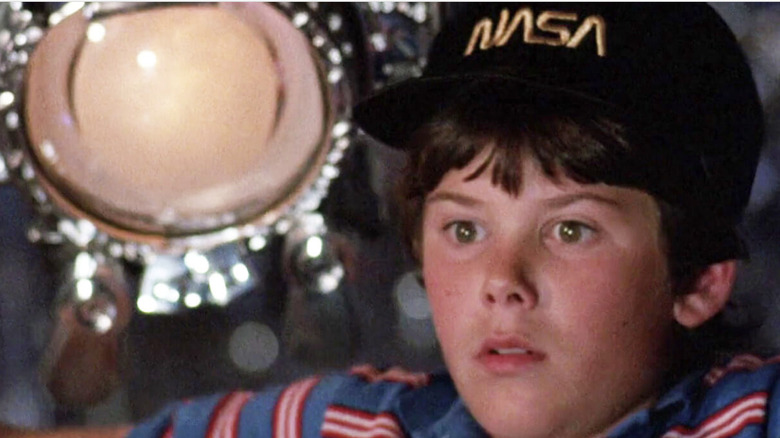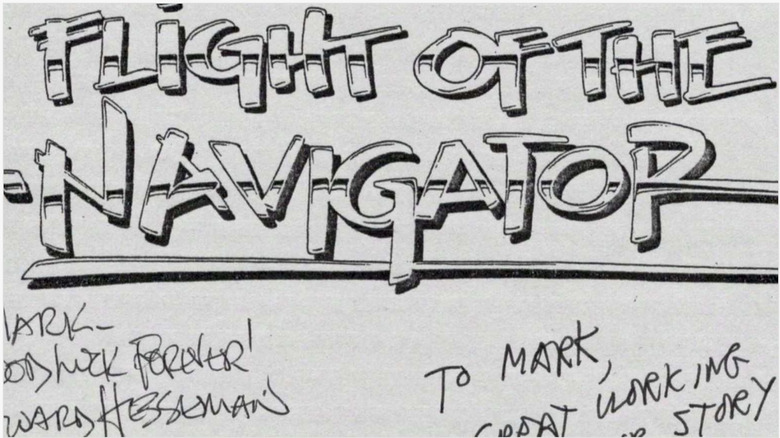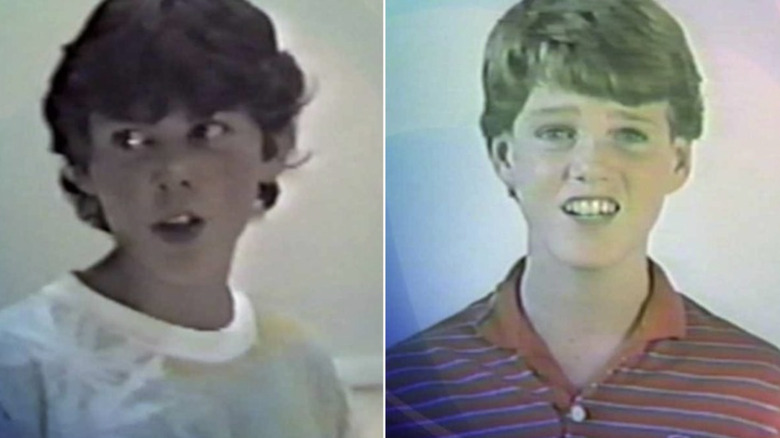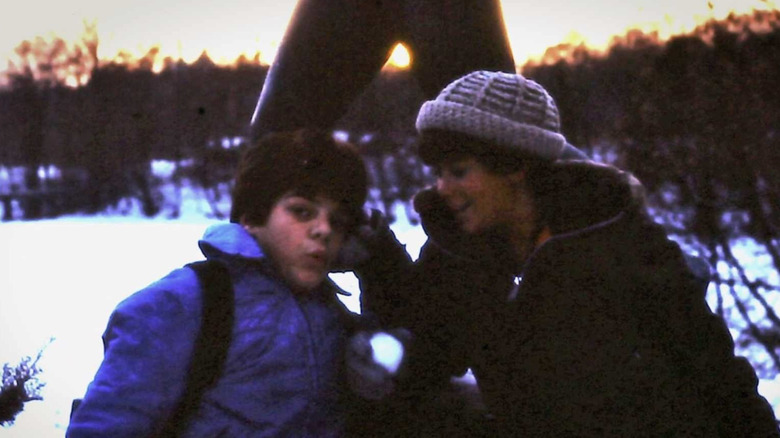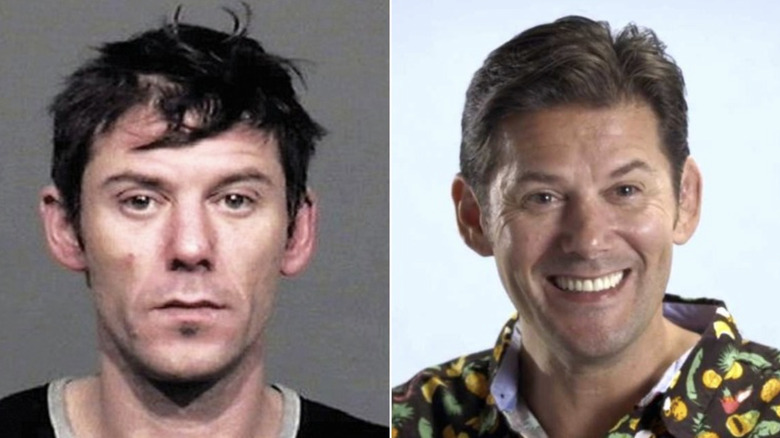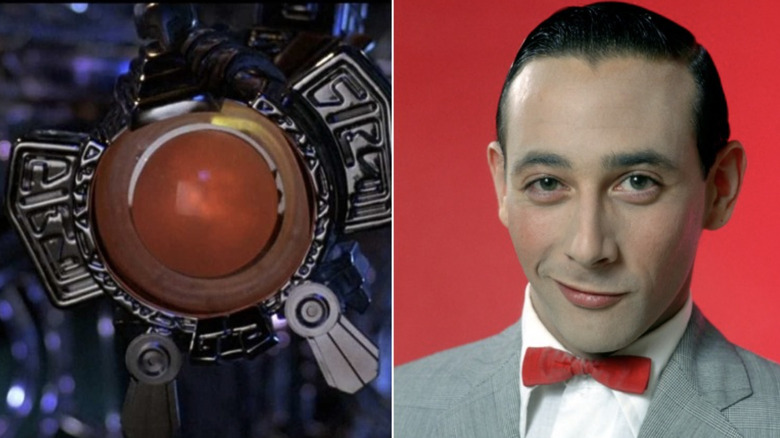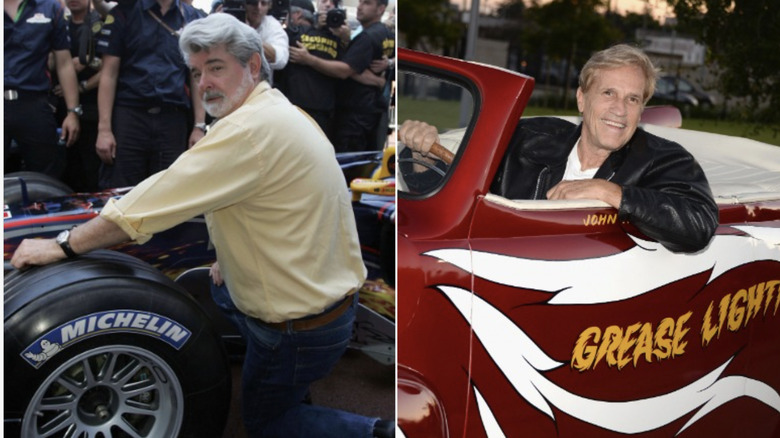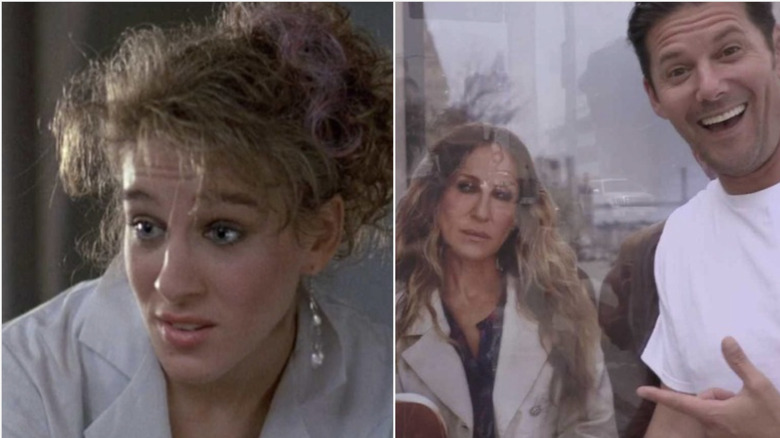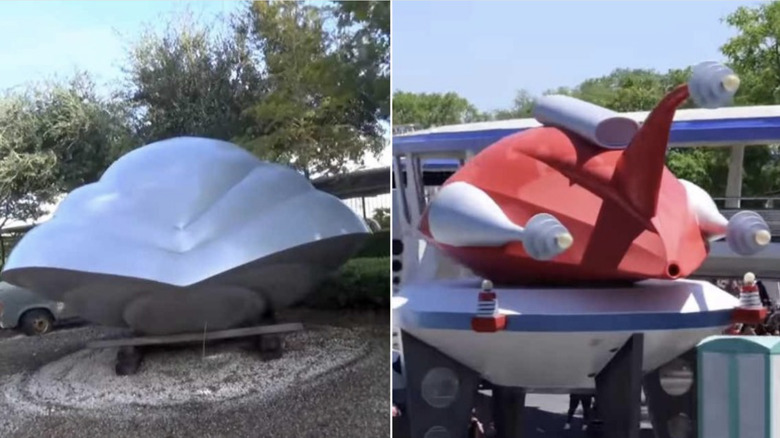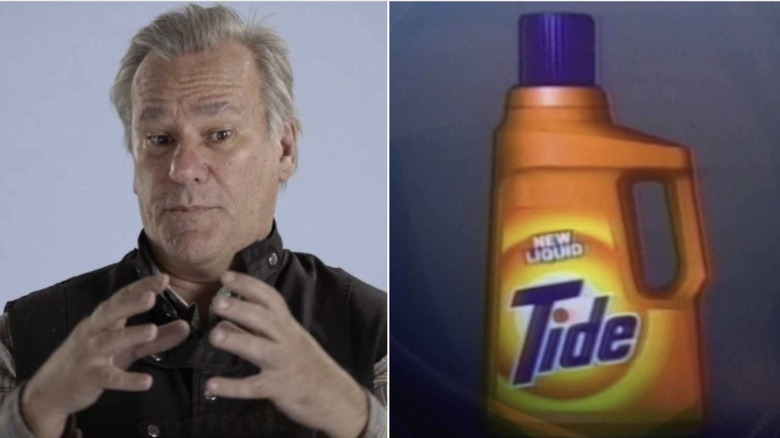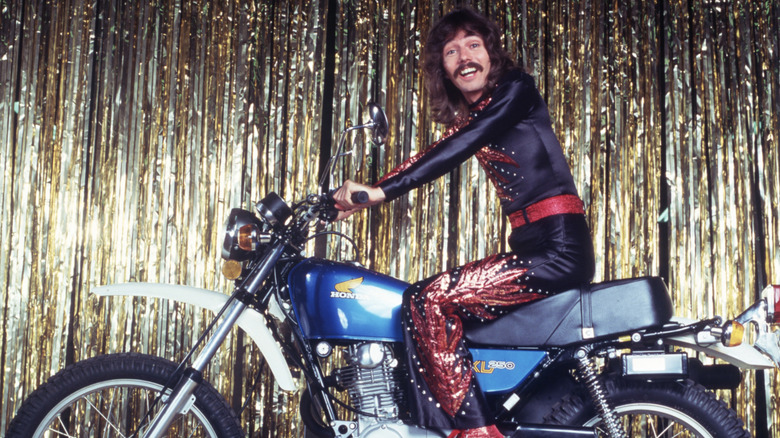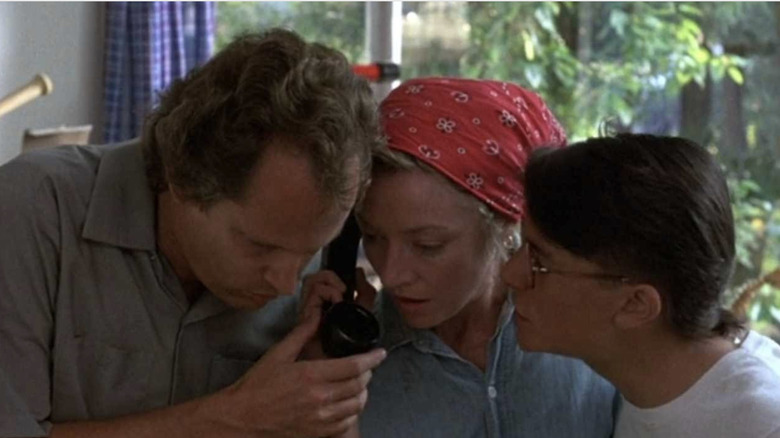The Untold Truth Of Flight Of The Navigator
In 1986, a Disney movie with groundbreaking (and computer breaking) effects touched down in theaters. It was called "Flight of the Navigator" and told the tale of a missing 12-year-old boy named David Freeman, who resurfaces 8 years later, not aging a day but having gained the skills of piloting an intergalactic spaceship and a newfound knowledge of the uncharted universe. While "Navigator" wasn't an instant smash hit by any means, critically or financially, it became one of those '80s family friendly live-action movies that struck a chord with those who discovered it via subsequent VHS and DVD releases, as well as constant airings on the Disney Channel.
In the years since, "Navigator" has become such a beloved property for Disney that the company recently announced plans to dust it off and give it a new "Flight" plan, with Bryce Dallas Howard directing a female-led reboot for their Disney+ streaming service.
Such excitement for a new chapter, however, also evokes nostalgic feelings about the original. So, after looking into what happened to the cast, now it's time to dig deeper — and unearth all the movie magic secrets of "Flight of the Navigator."
Compliance!
You Can't Be Serious
Mark H. Baker was a UCLA film student who came up with the initial story of what eventually became "Flight of the Navigator." The idea for his very first screenplay came from a dream, and was originally entitled "Vanished." In the 2020 documentary "Life After the Navigator," Baker explained the project's origin story. "It was [originally] more of a serious film. In my story, they build the ship from his memory, so they're experimenting with technology that they don't understand but David does, and it gets to a point where he realizes they're never going to let him go."
At one point, Brian de Palma had interest in directing it; John Avildsen of "Rocky" and "Karate Kid" fame later became attached as the helmer, before "Grease" and "Blue Lagoon" lenser Randal Kleiser got the call.
The film's theme, tone and script ended up a tug-of-war between the two companies involved in its production — Mark Damon's Producer Sales Organization and Disney. "There were two companies that made it, Producer Sales Organization and Disney," director Kleiser recalled in 2020. "Producer Sales Organization was an action movie place, they wanted to have governments trying to shoot down the spaceship and chases and things like that and Disney wanted to concentrate on the family story, so guess who won!"
In the end, Kleiser would say, "the compromises [between PSO and Disney] made the movie better."
Writer Baker reflected: "Most of the elements that I had in my film were in the final film, but it's the changes that really make it different."
Two additions did come from Kleiser himself, who dropped in references to a pair of pop culture classics he had worked on: "Starsky and Hutch," and "Grease" (via "You're The One That I Want," which can be heard on a radio).
Finding the Navigator
The filmmakers knew that if "Flight" were to fly, it had to find the perfect child actor to play "Navigator" David Freeman. Looking back in 2020, casting director Valorie Massalas explained, "They didn't want children that were trained, they wanted somebody who kind of walked in the door and was natural. So it was important for them to find an organic experience."
Casting took place across several U.S. cities, with the likes of Joaquin Phoenix and Chis O'Donnell considered for David. In his unearthed audition video, O'Donnell even wore an inverse colored striped polo shirt like the one David ended up wearing in the final film.
The role eventually went to Vancouver native Joey Cramer, who had worked with Disney on the failed pilot-turned-Disney Sunday Movie "I-Man" and as an extra on "The NeverEnding Story" (Falkor chased him down an alley). Cramer amazed director Randal Kleiser by being able to break into tears during his screen test.
"The moment I saw that, I knew I could get anything out of him if he was able to do that right away in the audition," Kleiser later said. "He cries several times in the movie and I never had to work with him; I just had to explain the situation and he could bring it to life."
Norway All The Way
A majority of the film takes place and was shot in sunny Florida, but due to "blocked funds" from one of the Producer Sales Organization financiers, they were obligated to shoot a portion of the film in ... Norway.
The only parts that made sense to shoot in Norway were the interiors of the spaceship. So, in February of 1986, the cast and crew packed up and arrived in 30 degrees below zero Oslo wearing shorts and t-shirts ("Navigator" puppeteer Tony Urbano noted the difficulty of the sudden shift thusly: "Have you ever tried to buy a parka in Fort Lauderdale, Florida?"). Working in a warehouse all day also ensured that the film's team would literally never see the light of day.
To make matters worse, they hired a Norwegian child who didn't speak a word of English to shoot scenes of Joey flying the ship, from an over-the-shoulders perspective behind him. The movements of the stand-in (or sit-in, if you will) had to be precise, matching how Cramer had previously moved in front of the camera, but Kleiser's directions kept getting lost in translation, making it "very, very complicated trying to work out telling the kid which way to move."
Kleiser later heard a rumor that the so-called "block funds" never materialized anyway. If that's true, he says, "we flew the crew from Florida to Norway for no reason!"
Plight of the Navigator
Joey Cramer's (born Deleriyes Joe August Fisher Cramer) star shined mightily bright in "Flight of the Navigator," but soon after filming wrapped, he "just wanted to be a kid again," Cramer explained in 2020, looking back on those days. He left Hollywood, even turning down the role of Wesley Crusher on "Star Trek: The Next Generation" on his way out the door.
Returning to school opened himself up to being bullied by classmates. Cramer yearned to "be normal; I was anything but normal and before I knew it my childhood was gone." He eventually fell down a rabbit hole of drugs and excess, funded by his "movie money," and was in and out of jail for several other offenses. One time, he was escorted by police officers who were fans of the film, and they all re-enacted the scene where he was being quizzed about what year it was and who the president was. Cramer's dark path came to a head when he was charged with robbing a British Columbia bank in 2016 — a cry for help.
Cramer has since cleaned up his life, and even returned to the industry he once turned his back on. His redemptive journey is told in the great documentary "Life After Navigator," written and directed by Lisa Downs. He is open to doing a "Navigator" sequel, incorporating unused ideas from Mark H Baker's original story, as well as contributing his own. As for the Bryce Dallas Howard remake? Cramer has mixed emotions, but would love to play the father figure.
Had he stayed in Hollywood, Cramer said he would "probably be dead by now." He was "the movie star kid who had no identity, and now I do." He added, "I don't need to hide who I am anymore. I'm not afraid anymore."
Pee-wee To The Max
David may be the navigator of the Trimaxion Drone Ship, but Max is the wired brains of the identified flying object, putting everything in motion. The filmmakers had a hard time trying to find Max's "voice," even, as Kleiser said, using "those machines that people use who have lost their voices." While filming, puppeteer Tony Urbano provided a "scratch track" for Max, as they searched for a "kid-like and fun" set of vocal cords. Cramer's co-star and "younger" brother Matt Adler was given the chance, but thinks his bad rendition of "I Get Around" by The Beach Boys "sunk" his chances.
Kleiser caught an episode of "Pee-wee's Playhouse," and having known Paul Reubens from the LA scene approached him about playing Max. "He didn't want any credit. He didn't want his name on it. I guess he just is a quirky guy and didn't want to have his real name so he used Paul Mall [like the cigarettes] as his name. But everybody knew it was him, I mean, the moment he did his laugh you knew!" Kleiser recalled.
Cramer and Reubens never got to work together during filming, as his voiceover work was added in post production. The two did briefly meet when Cramer came to see a taping of "Pee-wee's Playhouse," which he fondly remembered being "so cool!"
Reubens tapped Randal to direct and help realize his vision for his "Big Adventure" follow-up, 1988's "Big Top Pee-wee." The two also worked with Michael Jackson's giraffe for the film.
The Force Is Strong With The One
When Kleiser was a sophomore at USC, he became roommates with George Lucas. Film school was not seen as a serious career track in those days, with Kleiser saying, "At the time, studying film was kind of like studying basket weaving." While not in class, Kleiser was interested in nightlife, but Lucas would stay home, drawing up "these little star troopers." The two, along with Loretta Young's son Chris Lewis formed a short lived production company called Sunrise Productions, and worked on, but never completed a 1964 short by Kleiser called "Orgy Beach Party." Kleiser would later return the favor two years later by starring in Lucas' first narrative short, "Freiheit."
Flash forward years later and the two became filmmaking forces, with Lucas overseeing his mammoth "Star Wars" galaxy and Kleiser making "Grease" the word. When Kleiser took his first stab at science fiction with "Navigator," he sought advice from his college buddy, telling him about the idea of using a mirrored spaceship. Lucas had told him "'you better not do that, because you'll see the camera and it'll be really hard to shoot', but I decided to do it anyhow and I'm glad I did."
The filmmakers even squared off against each other at the box office in August of 1986, when "Flight of the Navigator" opened alongside Lucas' "Howard the Duck," as well as the sixth installment of "Friday The 13th." None of the three, however, were a match for James Cameron's "Aliens."
Kleiser inadvertently helped Lucas with casting. Paul Reubens' work in "Navigator" caught the ear of the makers of Disney theme parks motion simulator "Star Tours," who were having issues finding the right voice for their ride. With Lucas' blessing, they cast Reubens (again, uncredited) as the droid pilot RX-24. For his troubles he was given a free park pass, which he used a lot.
Parker? I Don't Even Know Her
When looking back after all these years, Joey Cramer speaks fondly of the cast and crew. In particular, on the "funny" and "thoughtful" scenes he shared with the actress who played the sympathetic NASA tech, and huge Twisted Sister fan, Carolyn McAdams. He said, "Those are the closest memories that come to me about the film was spending time with Sarah Jessica Parker, who just knocked me out as a human being."
Apparently the feeling is not mutual. Even though she once said "I've always just sort of done work that I wanted to do," that does not apply to playing Carolyn. In a 2018 interview with A.V. Club, Parker had a rather blunt assessment of her time with "the Navigator."
"It was a part. Like, literally, I just got a part. I went and did it," she explained. "That's what I did for most of my career. Nothing drew me to it. I can't — it was a job. That's exactly a paycheck. That's exactly what drew me to it. I can't even tell you what it was about or who I played. You know, all you want is a job. You're auditioning, you want to have as much experience as possible."
Perhaps the folks behind the remake might not want to bother making that phone call for a cameo.
Flight Safely Landed
Fresh out of California Institute of the Arts, Edward Eyth was hired to design the spaceship in a way "that had never been seen before." His original ideas launched a career that later included creating futuristic and classic concepts for films like "Captain EO," "Back to the Future II," "The Rocketeer," and many others, including reuniting on "Big Top Pee-wee" with Kleiser and Reubens.
The production team, including production designer William J. Creber, created two physical spaceships, one that was 700 pounds (and used for floating scenes) and another that was 1,450 pounds (with a full aluminum interior). When the film wrapped, they both found a home at Walt Disney World's MGM, now Hollywood Studios Park. For years, they could be seen in the Studio Backlot Tour, within the "bone yard" section, alongside such other revered movie vehicles as Herbie the Love Bug and one of Jabba's skiffs from "Return of the Jedi."
At some point (at least 20+ years ago), one of the two ships was moved to the Magic Kingdom, repainted red, given tailfins, spoilers and repurposed to become the "Cool Ship" drink station in Tomorrowland. The Hollywood Studios Backlot attraction closed in 2014 to make way for newer park developments, and the whereabouts of the second ship are currently unknown.
The Special Effects - A Turn of The Tide
In order to make their spaceship believable, and like nothing that had come before it, Kleiser needed a cutting edge special effects artist in a time when computer-generated imagery was in its infancy. The director didn't have to look far, having already worked with a very skilled one on his "Blue Lagoon," as well as Disney's "TRON" — his brother, Jeff.
Jeff wowed Randal by showing him a Tide commercial he had worked on where the detergent bottle "changed shape, smoothly morphing into a map of the United States." Coupled with another novel technique Jeff was working on, reflectance mapping, "which is taking the background and wrapping it onto a wireframe computer model and turning it into a mirrored surface," they knew they were at the cusp of creating something new and special.
Easier said than done. The computer Jeff and his effects team employed would crash "five or so times a day," and since it had very little disk space to begin with, it meant they "had no way of reshooting a scene other than re-rendering it from scratch each time." Some corners were cut using movie magic and practical magic (see the next segment), but the end results speak for themselves, and hold up to this day.
Their pioneering work helped usher in a new era of visual effects, and influenced other filmmakers as well. Jeff later talked with James Cameron, who admitted the "Navigator" spaceship "was his inspiration for the chrome terminator," the iconic T-1000 from "Terminator 2: Judgement Day."
Movie Magic Courtesy of An Actual Magician!
In the era of "Navigator," a single special effect shot could cost (according to Randal Kleiser) about $30,000. He wanted more effects shots, but to somehow save money in the process. So he turned to famed, mustachioed Canadian magician Doug Henning to help conjure up some stage magic to translate into some pure movie magic.
Henning's work went uncredited, but he did save the production money with his key contributions. One of the major ones was the metal steps leading into the spaceship.
"We built those steps with steel rods going away from the camera so you couldn't see them," Kleiser explained. "So that Joe could walk on the steps and they would give a little bit; he couldn't really do that with special effects, it was in camera and it looked really great."
Another Henning trick employed a crane, used to give the illusion of the spaceship floating, particularly in the gas station and hangar scenes. In actuality, the ship was suspended from the side, and later in post-production the crane's arm was erased.
Cursed!
Cursing is not something you typically associate with movies by the Walt Disney Company. Sure, there have been subliminal messages and innuendo hidden in their animation, but usually the dialogue stays clean cut. "Flight of the Navigator" marked only the third time a Disney film permitted, or let slip, a dirty word. "Navigator" let the word sh** fly twice, once by David's brother Jeff when he told him to not take any from NASA, and another time when a scientist's mind was blown and made it holy. When asked about it recently, Kleiser said, "I don't remember the profanity in "Flight of The Navigator."
The first two Disney films with profanity were Robert Altman's 1980 musical "Popeye" and 1985's Academy Award nominated "The Journey of Natty Gann." When fighting Bluto, Robin Williams as the sailor man cursed like one by letting the "s" word slip in the film, co-produced by Paramount Pictures. Ms. Gann was a little naughtier, dropping several "s" bombs and even the "b" word.
Walt must have been spinning in his grave.
